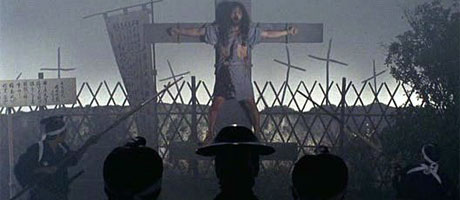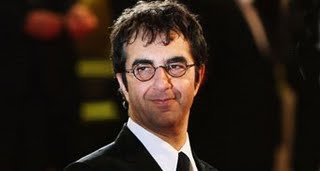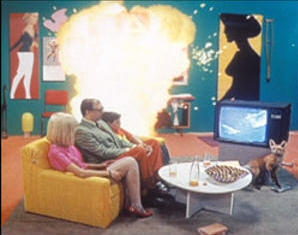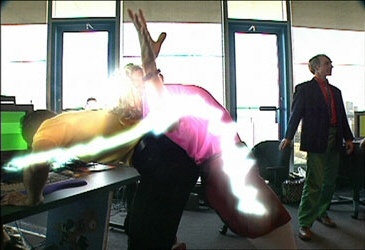
13 CURIOS FROM THE NEW CENTURY

christopher funderburg
As the first decade of the first century of the new millenia draws to a close, I've already started to hear conversations about the Best Films of the Decade. For some reason the number of Best Films of the Decade is limited to ten, but that's all beside the point anyway because I've never really been one for patently ridiculous labels like "Best" and "Greatest" - there's just no point in arguing that sort of thing. But what I have been thinking about are all of the truly unique films that have been made in the last ten years, the works of le cinema valuable for their curiosity factor alone - doggedly offbeat projects with eccentric styles employed to express anomalous ideas for no readily discernible audience.
I ended up having a little more to say about each of the 13 films on this list than I expected, so I'm dividing it up into three parts to be published over the next couple of days. On the simplest level, I hope the list makes you aware of some films of which you've never heard, even if you don't come away as fan of any of the films I mention. Obviously, some of the films on the list are challenging or off-putting or smelly, but even more of them are lovably weird and genuinely worth your time - at very least, I think the world could always use a little more appreciation (and, heck, understanding) for these singular artists pursuing singular ends...
Citadel

While waiting for funding to come through for a larger project, the perpetually frustrating Atom Egoyan fashioned this "home movie" documenting a family vacation to his wife's home in Lebanon. One the surface, it's an epistolary film addressed to the filmmaker's young son, a personal missive intended to explain the relationship between Egoyan and his wife (the boy’s mother), in particular the stresses caused to their marriage by the vacation in question. And while it is a thoughtful film full of painful personal exchanges, it's also more elusive than that: it's additionally an essayistic rumination on Middle-Eastern politics, an interesting tour of Lebanon’s history, a gorgeous but almost scientific examination of the physical landscape and, finally, a slyly sharp critique of documentary film artifice.
Much to the film's credit, those elements are mixed in such a way that separating on from another wouldn't be possible. For example, a memorable passage begins with Egoyan talking about jet-lag and exploring his hotel room, a bit of diary-style documentary filmmaking that attempts to make some interesting observations about mundane personal minutiae. From there, Egoyan watches some t.v. (because he's unable to sleep) and sees a documentary about the civil war in Lebanon. In voice-over, Egoyan explains that the documentary on t.v. is talking about one particular massacre that occurred and then he puts onscreen stills from the film featuring dead bodies in a small courtyard. Later, Egoyan suddenly realizes that he's seen the courtyard before – in fact, he was there in person! – and the films shifts to his footage from the courtyard, filmed when he was entirely unaware of the area's terrible historical significance.
But don't let the fact that Egoyan made Citadel on whim fool you: that he made the film just to kill time works to its advantage. He displays a heretofore hidden capacity as filmmaker for improvisational looseness and goofy charm – he's funny, intelligent guy and you couldn't ask for a better host for the meandering trip through a tangled web of family, history and politics. I genuinely didn't know he this capable as a filmmaker of, well, fun. The laid-back approach also ultimately serves the more complex material: this isn't a big, self-important tract on Political Issues and The Nature of History; the intimate air creates a sense of proportion and level-headedness around Big Subjects like "religious conflicts" and "historical perspective" of which most cinematic treatments of such things are completely incapable. This an emphatically "small" film, in the best sense of the word.
I should mention, however, the last ten minutes of the film is one of the most intense, scary pieces of cinema I've seen all decade. Egoyan and his wife (actress Arsinee Khanjian*) decide they want to take a tour of titular ruin, a crumbling citadel in a dangerous part of town. They enlist a shady tour-guide to take them to the off-limits (for tourists, anyway) structure and, from the beginning, Egoyan hesitations to trust the brusque, impatient escort. And the ominous narration and music lets you know his doubts are well-founded. The couple's trip to the citadel is ultimately a harrowing experience (especially for the audience), but to talk too much about the twists of the final reel would do this remarkable film a huge disservice – I'm normally indifferent to spoilers, but, trust me, this is one you want to go into with a clean slate. The ultimate resolution of the film spun me around so jarringly that I called into question everything I felt about what preceded it.
Unfortunately, Egoyan has decided to make the film won't be released on dvd and refuses to authorize any theatrical screenings as well.** His reasons for making the film unavailable are mysterious: I saw it at a screening at the Hot Docs documentary film festival in 2006 and he apparently screening it several more times for similarly select audiences in Toronto, so despite the current excessive restrictions he is willing to screen it in some limited circumstances. Unfortunately, the film is such an insignificant blip on the radar of even art-cinema (and made amidst a creative losing streak for Egoyan that has undoubtedly further depressed interest in his work) that there seems little chance of audiences having access to the filmmaker's best film since his break-through work, The Sweet Hereafter.
* You might recognize her from The Sweet Hereafter or Felicia's Journey, but hopefully not Adoration. Because, for your sake, it would be better if you didn't see Adoration.
** I should know – I've tried several times (to no avail) to get him (through the folks in his office) to let us screen it at the Jacob Burns Film Center.
*Corpus Callosum
 A hilarious metaphoric take on the medical term of the title, the heroically esoteric filmmaker Michael Snow's playful visual simile is on the level with his landmark 70's mind-benders Wavelength and <--->. Of course, a lot of audiences will deride those films as being the height of tedium, but that's only because there's virtually no way to describe them without making them seem impossibly boring and self-indulgent. Wavelength (a 42 minute zoom across a bare studio apartment to a photograph on the wall) and <---> (a ping-pong back-and-forth pan across the outside and then inside of a classroom) both suffer from being so outside the confines of what audiences are comfortable with that there's essentially no way to reassure potential viewers of their senses of humor, piercing intelligence and sheer cinematic gorgeousness. Their formal rigor could understandably be off-putting, they could never be accused of self-indulgence or aimlessness* - and *Corpus Callosum pulls off many of the same rare feats as those two canonized classics.
A hilarious metaphoric take on the medical term of the title, the heroically esoteric filmmaker Michael Snow's playful visual simile is on the level with his landmark 70's mind-benders Wavelength and <--->. Of course, a lot of audiences will deride those films as being the height of tedium, but that's only because there's virtually no way to describe them without making them seem impossibly boring and self-indulgent. Wavelength (a 42 minute zoom across a bare studio apartment to a photograph on the wall) and <---> (a ping-pong back-and-forth pan across the outside and then inside of a classroom) both suffer from being so outside the confines of what audiences are comfortable with that there's essentially no way to reassure potential viewers of their senses of humor, piercing intelligence and sheer cinematic gorgeousness. Their formal rigor could understandably be off-putting, they could never be accused of self-indulgence or aimlessness* - and *Corpus Callosum pulls off many of the same rare feats as those two canonized classics.
Once again, sounds heady, right? Maybe a bit of a chore to sit through, if not a punishing bore? The thing is, this movie is actually a breeze – chock full of sight gags, overloaded with erotic interludes, awash in inventive special effects and piled over with visual puns (some so cheesy that Carrot Top would blush), the movie uses the detritus of pop culture and the mechanics of entertainment as its building blocks for the hammy, hilarious, heartfelt candy-colored spectacle. From moment to moment, it reminded me of Roy Lichtenstein, those creepy energizer commercials with the plastic cowboys, Red Grooms and Mimi Gross' cartoon pop-art happenings, magazine ads from the 1950's, Frank Tashlin's Will Succes Spoil Rock Hunter? and The Girl Can’t Help It!, youtube viral videos done up in Adobe After Effects, bad early video editing star-wipes, flash animation and highly artificial sitcoms.
 The camera alternates between motionless and relentless motion; Snow's signature slow zooms, a repetitive rightward tracking, a suddenly still square. In *Corpus Callosum, there's a layer of motion added from the fact that the image itself almost never stops moving: Snow digitally stretches and distorts the picture to elongate the characters bodies, squish them up again, digitally zooms in to expose the grain, shrinks everything down again – he calls up every possible digital effect to contort the picture in a constant assault on the stability of the film's ontology. Yes, a lot of this looks silly but the film is imbued with an inviting goofiness, so it alls just ends up being part of the fun.
The camera alternates between motionless and relentless motion; Snow's signature slow zooms, a repetitive rightward tracking, a suddenly still square. In *Corpus Callosum, there's a layer of motion added from the fact that the image itself almost never stops moving: Snow digitally stretches and distorts the picture to elongate the characters bodies, squish them up again, digitally zooms in to expose the grain, shrinks everything down again – he calls up every possible digital effect to contort the picture in a constant assault on the stability of the film's ontology. Yes, a lot of this looks silly but the film is imbued with an inviting goofiness, so it alls just ends up being part of the fun.
Like Wavelength, the dissonant soundtrack is just as powerful and memorable as anything onscreen. Interestingly, the disjointed, surprising cavalcade of sounds is treated like the onslaught of digital effects: they are both overlaid on the original image in a way stresses the artificial nature of what's onscreen. They are obvious artifices that can never merge to create an organic whole with the "reality" of the filmed images. The digital effects are employed with a low budget enthusiasm that never fails to be charming – the explosions, lightning strikes, streaks of tears and random color bursts peppered throughout the film have an intentional lo-fi quality that, again, are used for a deeply academic highbrow purpose while still being mainly funny, clever and goofy. I can't stress enough how genuinely likable and open-hearted this film is – its heavily dissonant tactics aren't meant to beat an audience into submission with their inscrutable genius and self-important obscurity; they're meant to give you something to look at and laugh with and think about. Who could have a problem with that?
* Those are Warhol's films you’re thinking of. One of the many ways in which he ruined modern art for everybody.
<<Previous Page 1 2 Next Page>>
home about contact us featured writings years in review film productions
All rights reserved The Pink Smoke © 2009